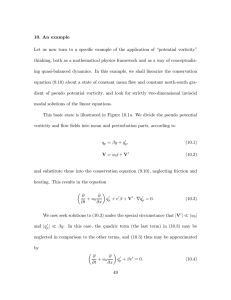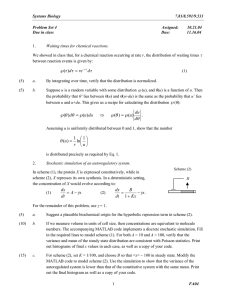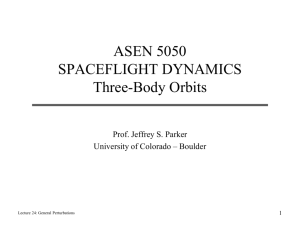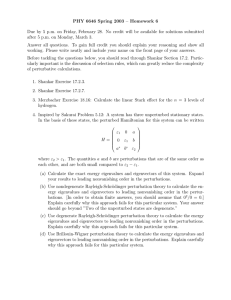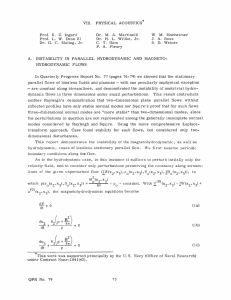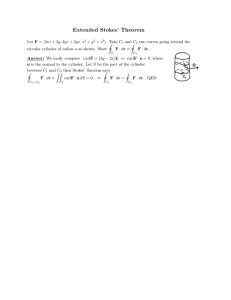INFLUENCE OF SWIRL VIBRATIONS ON FLOW IN LONG CYLINDER
advertisement
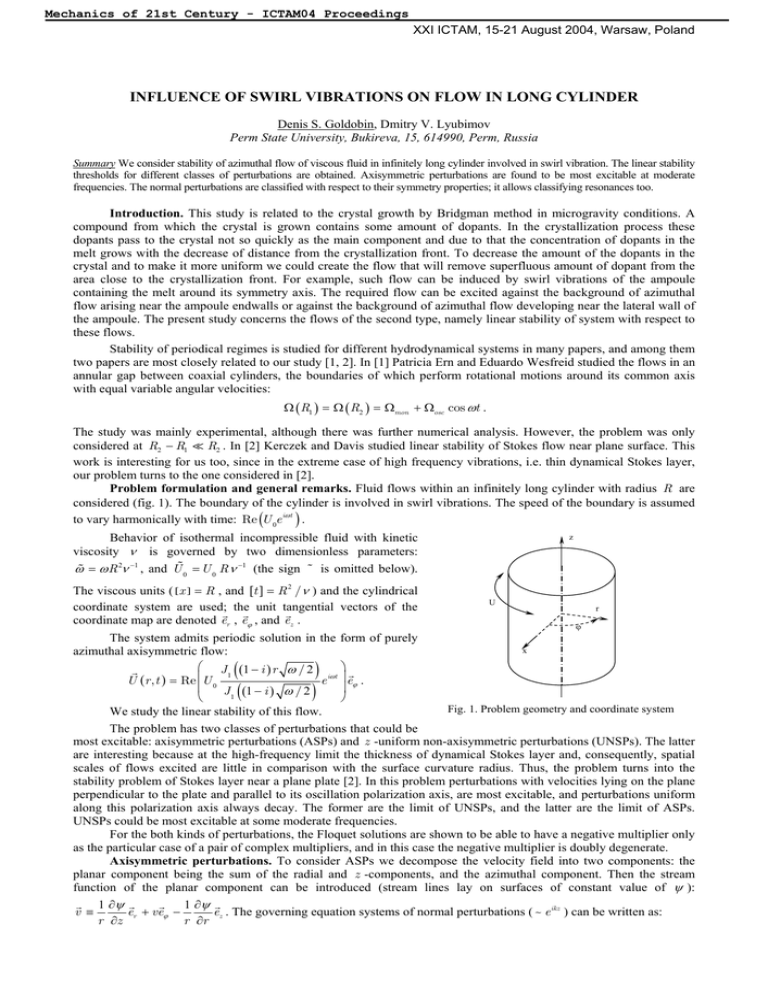
Mechanics of 21st Century - ICTAM04 Proceedings XXI ICTAM, 15-21 August 2004, Warsaw, Poland INFLUENCE OF SWIRL VIBRATIONS ON FLOW IN LONG CYLINDER Denis S. Goldobin, Dmitry V. Lyubimov Perm State University, Bukireva, 15, 614990, Perm, Russia Summary We consider stability of azimuthal flow of viscous fluid in infinitely long cylinder involved in swirl vibration. The linear stability thresholds for different classes of perturbations are obtained. Axisymmetric perturbations are found to be most excitable at moderate frequencies. The normal perturbations are classified with respect to their symmetry properties; it allows classifying resonances too. Introduction. This study is related to the crystal growth by Bridgman method in microgravity conditions. A compound from which the crystal is grown contains some amount of dopants. In the crystallization process these dopants pass to the crystal not so quickly as the main component and due to that the concentration of dopants in the melt grows with the decrease of distance from the crystallization front. To decrease the amount of the dopants in the crystal and to make it more uniform we could create the flow that will remove superfluous amount of dopant from the area close to the crystallization front. For example, such flow can be induced by swirl vibrations of the ampoule containing the melt around its symmetry axis. The required flow can be excited against the background of azimuthal flow arising near the ampoule endwalls or against the background of azimuthal flow developing near the lateral wall of the ampoule. The present study concerns the flows of the second type, namely linear stability of system with respect to these flows. Stability of periodical regimes is studied for different hydrodynamical systems in many papers, and among them two papers are most closely related to our study [1, 2]. In [1] Patricia Ern and Eduardo Wesfreid studied the flows in an annular gap between coaxial cylinders, the boundaries of which perform rotational motions around its common axis with equal variable angular velocities: Ω ( R1 ) = Ω ( R2 ) = Ωmon + Ωosc cos ωt . The study was mainly experimental, although there was further numerical analysis. However, the problem was only considered at R2 − R1 R2 . In [2] Kerczek and Davis studied linear stability of Stokes flow near plane surface. This work is interesting for us too, since in the extreme case of high frequency vibrations, i.e. thin dynamical Stokes layer, our problem turns to the one considered in [2]. Problem formulation and general remarks. Fluid flows within an infinitely long cylinder with radius R are considered (fig. 1). The boundary of the cylinder is involved in swirl vibrations. The speed of the boundary is assumed to vary harmonically with time: Re (U 0e iωt ) . Behavior of isothermal incompressible fluid with kinetic viscosity ν is governed by two dimensionless parameters: ω = ω R 2ν −1 , and U 0 = U 0 R ν −1 (the sign is omitted below). The viscous units ( [x ] = R , and [t ] = R 2 /ν ) and the cylindrical coordinate system are used; the unit tangential vectors of the G G G coordinate map are denoted er , eϕ , and ez . z U r ϕ The system admits periodic solution in the form of purely x azimuthal axisymmetric flow: J (1 − i ) r ω / 2 G G 1 U (r , t ) = Re U 0 e iωt eϕ . J 1 (1 − i ) ω / 2 Fig. 1. Problem geometry and coordinate system We study the linear stability of this flow. The problem has two classes of perturbations that could be most excitable: axisymmetric perturbations (ASPs) and z -uniform non-axisymmetric perturbations (UNSPs). The latter are interesting because at the high-frequency limit the thickness of dynamical Stokes layer and, consequently, spatial scales of flows excited are little in comparison with the surface curvature radius. Thus, the problem turns into the stability problem of Stokes layer near a plane plate [2]. In this problem perturbations with velocities lying on the plane perpendicular to the plate and parallel to its oscillation polarization axis, are most excitable, and perturbations uniform along this polarization axis always decay. The former are the limit of UNSPs, and the latter are the limit of ASPs. UNSPs could be most excitable at some moderate frequencies. For the both kinds of perturbations, the Floquet solutions are shown to be able to have a negative multiplier only as the particular case of a pair of complex multipliers, and in this case the negative multiplier is doubly degenerate. Axisymmetric perturbations. To consider ASPs we decompose the velocity field into two components: the planar component being the sum of the radial and z -components, and the azimuthal component. Then the stream function of the planar component can be introduced (stream lines lay on surfaces of constant value of ψ ): 1 ∂ψ G G 1 ∂ψ G G v ≡ er + veϕ − ez . The governing equation systems of normal perturbations ( ~ e ikz ) can be written as: r ∂z r ∂r ( ( ) ) Mechanics of 21st Century - ICTAM04 Proceedings XXI ICTAM, 15-21 August 2004, Warsaw, Poland Ωt + i 2kU v = LΩ ; r Ω = −Lφ ; 1000 ik (rU ) ' φ = Lv ; r r = 1: v = φ = φ ' = 0. vt + Ω ≡ −∂ z vr + ∂ r vz Here −1 −2 is vorticity, U0 100 φ ≡ ψ /r , L ≡ ∂ + r ∂ r − r − k is Laplacian, and ' denotes differentiating with respect to radius. 10 Non-axisymmetric perturbations uniform 0 20 40 60 80 100 along the cylinder axis. The most excitable nonaxisymmetric perturbations are probably the ones ω uniform along the cylinder axis. UNSPs can be sorted Fig. 2. The boundary of linear stability to ASPs. The circles into two classes: (i) purely shear flows along the cylinder show the result of local minimizing the critical vibration axis, and (ii) flows with a velocity field perpendicular to amplitude with respect to wavenumber; the lines run through this axis. We have strictly proved the first-class the points of the global minima. perturbations to decay always. G G Introducing the stream function ( v = −∇ × (ψ ez ) ) for two-dimensional flow uniform along the cylinder axis, we 2 r 2 can obtain the governing equation of a perturbation with the quantum azimuthal number m (i.e., the perturbation fields ~ e imϕ ) and boundary conditions in the form of im Lmψ t + ( Re (U ) Lmψ + ω Im (U )ψ ) = Lm Lmψ ; r ψ (r = 0 ) = ψ (r = 1) = ψ ' (r = 1) = 0 . Here Lm ≡ ∂r2 + r −1∂ r − m 2r −2 is Laplacian. Numerical simulation. The spectral method is convenient for investigating our system. The basis of eigenfunctions of the perturbations behavior problem of the static fluid is used. The numerical simulation of the system shows that the first 15 basic functions are sufficient to get accurate enough (the error ~1%) results on system stability to perturbations of both kinds. The obtained results on the linear-stability threshold of azimuthal flow are presented on the fig. 2. Results and conclusion. The numerical simulation shows that the most excitable perturbations are ASPs up to the frequencies providing the dynamical Stokes layer thickness ~ 1 / 10 cylinder radius, and the critical vibration amplitudes for UNSPs are much more than the ones for ASPs at moderate and low frequencies. Interest in UNSPs is caused by the high-frequency limit, at which the problem turns into the stability problem of oscillatory Stokes layer near a plane plate. In this problem the perturbations uniform along the vibration direction, which are the limit of ASPs, always decay, while non-uniform ones can be excited [2]. It was the reason for expecting that UNSPs can be most excitable at low and moderate vibration frequencies. This expectation is proved false. ASPs are found to have the following properties. Firstly, solutions on the stability threshold have been found to correspond to the unit multiplier. Secondly, the planes of zeros of the z -component of the velocity field of the normal perturbation are shifted by the perturbation wavelength quarter from the planes of zeros of the azimuthal component of the same field. Thirdly, different “balloons” on the stability diagram correspond to perturbations of different classes: flows with a purely azimuthal time-averaged velocity field and flows with a purely planar one. The equation symmetry similar to the one allowing classifying ASPs, results in the following for UNSPs. When G G one decomposes the periodic velocity field v (r , t ) of a critical perturbation into two parts: symmetric G G G G G G G G vs (r , t ) = vs (r , t + π / ω ) and anti-symmetric va (r ,t ) = − va (r , t + π / ω ) to the time-shift for the modulation halfG period, then the zeros of the azimuthal component of the symmetric velocity field part vs are turned by the angle π / 2m (a fourth of the angle period) from the zeros of the azimuthal component of the anti-symmetric velocity field G part va . Thus, the linear stability of the azimuthal flow of viscous incompressible fluid in a long cylinder involved into swirl vibrations is studied. The stability threshold is found. Acknowledgments. The research described was supported by ESA from ESA-ESTEC Contract 15637/01/NL/SH, and by Award No. PE-009-0 of the U.S. Civilian Research & Development Foundation for the Independent States of the Former Soviet Union (CRDF). Bibliography [1] Ern, P. & Wesfreid, J. E. 1999 Flow between time-periodically co-rotating cylinders. J. Fluid Mech. 397, 73-98. [2] Kerczek, C. von & Davis, S. H. 1974 Linear stability theory of oscillatory Stokes layers. J. Fluid Mech. 62, 753-773. << session << start

